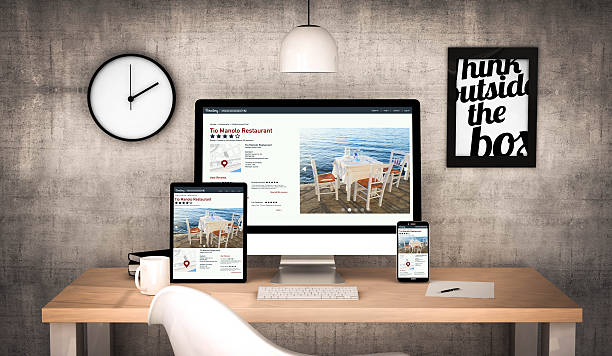Call Today!
(541) 903-4789
(click to call from a mobile device)
(541) 903-4789
(click to call from a mobile device)
7 Tips for Designing Your WebsiteA website can make your business stand out from other businesses that don't have one. 71% have websites for their small businesses.
A website is one thing. However, a website that is well designed is another. Without a professional small business website design, your site will fail. It is not easy to create a seamless website design. We can help you design your small business website. Today's post will highlight a few tips to help you design a small business website that is both beautiful and useful for your business goals. Let's get to it without wasting too much time. 1. Make sure your website is easy to navigate A non-functional and difficult-to-navigate website is a huge turn-off for web visitors. It is important to make it easy for visitors to navigate your website. This is possible by creating a well-planned website structure and design. It should be easy to use and intuitive. You don't want your visitors to become lost on your site. Consider adding a search bar to your website. This makes it easy for visitors to quickly find the information they are looking for without having to navigate through your entire site. Before you make your website live, test it on various devices and browsers. Websites that aren't working properly won't be allowed on the World Wide Web. 2. Choose Color Palettes and Themes That Reflect Your Brand Your brand's identity should be reflected in your website design. Your website should reflect your brand's identity. This means that colors, fonts, and images should be consistent with the brand's style guidelines. This will allow you to create a consistent and cohesive look for your website. You should also use color palettes and themes that are appealing to your target audience. This will make your visitors feel more comfortable and enjoy their visit to your website. |
What's Your SEO Report Card Score?
|
3. Use relevant and high-quality images
Business site owners often upload any photo that they find to their websites. Most people are unaware of the negative effects that low-quality images can have on their website design.
Remember to use relevant, high-quality images for your website. Your website will look polished and professional if you use high-quality images. Relevant photos can help you send the right message and design to your target audience.
Consider using images that are:
4. Select a cohesive website layout
The layout of your website should be simple and consistent. Small business owners often make the common mistake of cramming too many details onto one page. This can lead to a messy and unorganized appearance that is more harmful than beneficial.
Choose a layout that will allow you to present your content in an organized, visually appealing way. Grid-based layouts are one way to achieve this. This layout structures content using a series columns and rows.
Grid-based layouts make it easy to design a well-organized website.
The card layout is another popular option. Small businesses who want to show a lot of information but not overwhelm their customers will love card layouts.
5. De-clutter Your Website
Websites that are minimalist have more design options than those with more complex designs. This is because website owners don't need to do as much work. Too much clutter on your website can hinder the ability to design a website that is functional and attractive. To improve the overall design of your website, de-clutter it.
You should eliminate any pages, blog posts, images, or other content that are taking up space on the website. This will allow you to create a more clean and organized website design.
De-cluttering your website's navigation menu is also important. This will ensure that your visitors are able to navigate your site easily without feeling overwhelmed.
6. Optimize for Mobile Devices
Did you know that over half internet users use mobile devices to surf the web? Optimize your website for mobile devices while improving your web design.
It is important that your website design can be viewed on any screen size. Your site should be easy to view for visitors without the need to scroll horizontally or zoom in.
You can make your website mobile-friendly for small businesses in several ways:
A professional website designer can help you create a mobile-friendly website in no time.
7. Make Your Website Fast and Responsive
Your small business website's success depends on its speed and responsiveness. A slow website loading time is unacceptable. Studies show that website users expect websites to load within three seconds.
If your website is slow, there are a few things you can do to speed it up. Check the hosting plan for your website. Consider upgrading to a dedicated or VPS server if you are on a shared hosting account.
Optimizing your images can help speed up small business websites. You should ensure that all images are in the correct file format and compressed. To speed up your site's loading times, you can also use a Content Delivery Network (CDN).
Simplified Website Design for Small Businesses
Your small business website design can improve user experience and help you rank higher in search engine results pages. To attract more people to your website, you can use the tips provided above. Consistency is key. Be consistent and your website will grow.
If you need help optimizing your small business websites for more traffic, please contact us. We'd love to see if you are a good fit to work with.
Business site owners often upload any photo that they find to their websites. Most people are unaware of the negative effects that low-quality images can have on their website design.
Remember to use relevant, high-quality images for your website. Your website will look polished and professional if you use high-quality images. Relevant photos can help you send the right message and design to your target audience.
Consider using images that are:
- Convey emotion
- Tell a story
- High resolution
- Your brand identity should reflect your brand
4. Select a cohesive website layout
The layout of your website should be simple and consistent. Small business owners often make the common mistake of cramming too many details onto one page. This can lead to a messy and unorganized appearance that is more harmful than beneficial.
Choose a layout that will allow you to present your content in an organized, visually appealing way. Grid-based layouts are one way to achieve this. This layout structures content using a series columns and rows.
Grid-based layouts make it easy to design a well-organized website.
The card layout is another popular option. Small businesses who want to show a lot of information but not overwhelm their customers will love card layouts.
5. De-clutter Your Website
Websites that are minimalist have more design options than those with more complex designs. This is because website owners don't need to do as much work. Too much clutter on your website can hinder the ability to design a website that is functional and attractive. To improve the overall design of your website, de-clutter it.
You should eliminate any pages, blog posts, images, or other content that are taking up space on the website. This will allow you to create a more clean and organized website design.
De-cluttering your website's navigation menu is also important. This will ensure that your visitors are able to navigate your site easily without feeling overwhelmed.
6. Optimize for Mobile Devices
Did you know that over half internet users use mobile devices to surf the web? Optimize your website for mobile devices while improving your web design.
It is important that your website design can be viewed on any screen size. Your site should be easy to view for visitors without the need to scroll horizontally or zoom in.
You can make your website mobile-friendly for small businesses in several ways:
- Use larger font sizes
- Make use of more white space
- Use responsive design
A professional website designer can help you create a mobile-friendly website in no time.
7. Make Your Website Fast and Responsive
Your small business website's success depends on its speed and responsiveness. A slow website loading time is unacceptable. Studies show that website users expect websites to load within three seconds.
If your website is slow, there are a few things you can do to speed it up. Check the hosting plan for your website. Consider upgrading to a dedicated or VPS server if you are on a shared hosting account.
Optimizing your images can help speed up small business websites. You should ensure that all images are in the correct file format and compressed. To speed up your site's loading times, you can also use a Content Delivery Network (CDN).
Simplified Website Design for Small Businesses
Your small business website design can improve user experience and help you rank higher in search engine results pages. To attract more people to your website, you can use the tips provided above. Consistency is key. Be consistent and your website will grow.
If you need help optimizing your small business websites for more traffic, please contact us. We'd love to see if you are a good fit to work with.
Call Today!
(541) 903-4789
(click to call from a mobile device)
(541) 903-4789
(click to call from a mobile device)

